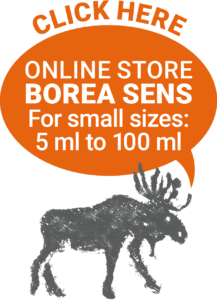BLACK SPRUCE WOOD ESSENTIAL OIL

Latin Name: Picea mariana
French Name: Épinette Noire
English Name: Black Spruce
Botanical Family: Abietaceae or Pinaceae
Origin: Canada
Harvest time: January to December
Distilled Part: Wood
Organoleptic Properties: Woody
Components: Sabinene, α et β-selinene, α et β-pinene, Terpinen-4-ol, γ-terpinene, Bornyl acetate
ORIGIN
Black Spruce is a majestic conifer ranging in height from of 8 to 25 meters. These trees look after our Canadian forests from coast to coast, because this conifer grows where other species cannot grow. Favoring moist, sandy or peaty soils, this tree covers North America mainly from Canada’s Far North to the edge of the low Arctic tundra, as well as the northeastern United States. Its twigs are rough and its frayed bark is reddish brown when young and darker when mature. Its greyish-green needles are straight and tight along its branches. Its fruit is a small purple cone that changes to light brown. Of the forty varieties of spruce, it is the most resistant to very cold climates. It can withstand up to -60 degree Celsius temperatures according to some studies. Without its biggest enemy, which is fire, this tree could live up to 280 years.
HISTORY
Native people have been using many medicinal plants from the boreal forest for thousands of years for healing purposes. This knowledge is generally held as a form of oral tradition. Cree from the woodlands used Black Spruce as an anti-diarrheal medication by making infusions from the cones. At other times the needles and cones were used to treat diabetes. For burns, they made balms from Black Spruce resin and chewed on cones to relieve toothache.
The Montagnais First Nations from the Quebec Province used Black Spruce to prepare infusions against sore throats and to cure coughs. Native American children chewed the resin to improve the whiteness of their teeth. They attributed to Black Spruce powerful properties against scurvy. Used mainly to build settlers’ homes, the tree was also used to brew spruce beer made from: needles, cones and molasses. Under the pretext of preventing scurvy, this drink flowed freely in the evenings with the clergyand on board ships!
In 1772, the English physician, Henry Taylor, discovered a method to extract the essential oil from the spruce and recommended it for respiratory diseases. Dr. Taylor is also the founder of the first distillery in Québec City.
BENEFITS
Physical
Black Spruce essential oil increases energy metabolism and stimulates the body.
In synergy with Scotch Pine essential oil, it balances the endocrine system. It is an indispensable and very effective supplement against the symptoms of perimenopause. Apply a few drops in the morning on the adrenals and lower back to stimulate the body and combat fatigue and exhaustion.
This essential oil is a very good anti-inflammatory in cases of rheumatoid arthritis, inflammation of the Achilles tendon, sciatica, sprains. Simply apply in a gentle massage: Mix a few drops of Black Spruce and Wintergreen essential oil mixed with St. John’s Wort oil on the affected area 2 to 3 times a day to relieve lower limb pain.
- Circulatory System: cardiac and lymphotonic antispasmodic
- Skin System: anti-inflammatory at the initial stage, antibacterial, provides sedation, relaxation and relief.
- Digestive System: aperitif, eupeptic, stomachic, intestinal antispasmodic (with analgesic, antiparasitic and antifungal properties), relieves knotted solar plexus spasms.
• Endocrine System: cortico-mimetic (pituitary-adrenal axis and adrenal axis pituitary-ovarian gland).
• Immune System: airborne antiseptic, antifungal, antibacterial, antiviral, antiparasitic.
• Respiratory System: bronchial antispasmodic, pulmonary decongestant, antioxidant, bronchial anti-inflammatory (including tuberculosis mycobacterium), antitussive and expectorant.
• Nervous System: relaxing, neurotonic: regulates serotonin (the hormone of happiness), promotes sleep and calms chronic pain.
• Osteoarticular System: anti-inflammatory, analgesic, decongestant.
• Genitourinary System: spasmolytic for pelvic plexus and knotted sacrum.
Psychic
Releases serotonin, which has the effect of acting as a natural antidepressant, increasing
the feeling of well-being and inner calm, as well as increasing empathy.
• Psycho tonic.
• Adaptogen.
Uses: Intestinal and cutaneous mycoses (candida), intestinal and cutaneous parasites (hookworms and giardia lamblia), acne, psoriasis, eczema, hyperthyroidism, bronchitis, sinusitis, catarrh, asthenia (fatigue), solar plexus spasm, muscular rheumatism, arthritis, inflammatory prostatitis, immunosuppression.
Contraindications: To avoid for the first three months of pregnancy and in cases of hypothyroidism; may cause redness with long-term, pure dermal application, especially if the product is oxidized.
Recommendation: Essential oils are wonderful for the well-being of humans, animals, insects and plants. There are many books that discuss aromatherapy and you should refer to them for proper and safe use. We also recommend that you consult a professional in aromatherapy who will be able to target the biochemical groups and aromatic molecules of essential oils and thus increase the effectiveness of your care.
Essential oils should be stored in a cool, dry place, protected from light and air.
The information provided on this website is NOT a recommendation of a cure or the treatment of a medical condition or disease.
References
- Frère Marie-Victorin, Rouleau Ernest, Brouillet Luc et collaborateurs, Flore laurentienne 3e édition, Gaëtan Morin Éditeur ltée, 2002.
- Moerman Daniel E., Native American Ethnobotany, Timber Press, Portland, Oregon, 1998.

